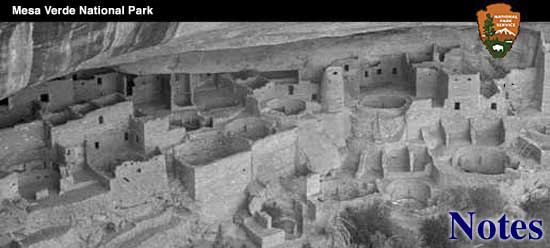

|
The numerous limonite concretions which abound in the sandstone members of the Mesa Verde formation are objects of great interest to visitors. They may be immediately recognized on the surface of the sandstone by their hollow centers, yellowish-brown color, varied shapes, and the manner in which they project above the surrounding matrix of sandstone. The material of which they consist is insoluble in water and is more resistant to obliterating erosive processes than the consolidated quartz granules which make up the sandstone formation in which the concretions are imbedded. The iron of the limonite concretions is originally brought down by circulating ground waters in the form of the carbonate of iron. The subsequent loss of the carbon dioxide from the carbonate, converts the iron carbonate into the oxide, with the iron remaining in the ferric state and incorporating three molecules of water into itself to form the mineral limonite (2Fe2O3 • 3H2O). This reaction may be more clearly expressed by the following equation: 2 Fe2(CO3)3 + 3 H2O → 2 Fe2O3 • 3 H2O + 6 CO2
Upon the conversion into the oxide of iron in the hydrated form of the iron carbonate, the hydrated iron oxide is deposited about some nucleus, a fossil, a twig, or a leaf—and the concretion has it inception. As long as deposition continues, the concretion will grow, and with the cessation of the activity of the ground water in bringing down the soluble material to be deposited upon the loss of carbon dioxide, the concretion reaches its stage of maturity. Subsequently, upon exposure, the nucleus may be removed. If the nucleus is a twig or a leaf it may be decomposed;—if a fossil, it may be removed in solution. Usually, this is just what happens, for most concretions that are found exposed on the surface have their nulei removed, thus accounting for the hollow centers. It is not necessary, however, to have some definite object serve as a nucleus to induce deposition. Sometimes the deposition of the limonite begins at some point, and the minute portion suffices to stimulate further deposition about itself. Thus, we have a concretion without any material serving as a nucleus, different from the material which constitutes the concretion itself. The shapes and sizes of concretions differ in a spectacular manner. Some are disc-shaped, ovoid, spherical,—some are shaped like animals or crucifixes, and are regarded with superstition by some people; others reach a length of one hundred feet and a breadth of five or six feet and resemble huge logs. The Mesa Verde, however, is lacking in such large concretions. | ||||||
| <<< Previous | > Cover < | Next >>> |
vol3-2e.htm
14-Oct-2011